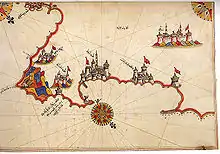Turks in Italy
Turks in Italy, also referred to as Turkish Italians or Italian Turks, (Turkish: İtalya Türkleri) are Italian citizens of Turkish origin. Although some Turks came to Italy as Ottoman migrants, the majority of Italian Turks descend from the Republic of Turkey; moreover, there has also been Turkish migration from other post-Ottoman countries including ethnic Turkish communities which have come to Italy from the Balkans (e.g. from Bulgaria, Greece, Kosovo, North Macedonia and Romania), the island of Cyprus, and more recently Iraq and Syria.
| Total population | |
|---|---|
| Regions with significant populations | |
| Languages | |
| Religion | |
|
History
Ottoman migration

During the 15th century, the Ottoman Empire was expanding mightily in southeastern Europe. It completed the invasion and occupation of the Byzantine Empire in 1453 under Sultan Mehmet II by conquering Constantinople and Galata. It seized Genoa's last bastions in the Black Sea in 1475 and Venice's Greek colony of Euboea in 1479. Turkish troops invaded the Friuli region in northeastern Italy in 1479 and again in 1499–1503. The Apulian harbor town of Otranto, located about 100 kilometers southeast of Brindisi, was seized in 1480, but the Turks were routed there in 1481 when Mehmet died and a war for his succession broke out. Cem Sultan, pretender to the Ottoman throne, was defeated despite being supported by the pope; he fled with his family to the Kingdom of Naples, where his male descendants were bestowed with the title of Principe de Sayd by the Pope in 1492. They lived in Naples until the 17th century and in Sicily until 1668 before relocating to Malta (Turkic Italian: Итољйон Тұрклори).
From the early 17th century through to 1838, the Fondaco dei Turchi served as a one-building-ghetto for Venice's Ottoman Turkish population (thus "dei Turchi"). The fondaco then served as a combination home, warehouse, and market for the Turkish traders. When the Venetian Republic was conquered and abolished by Napoleon Boneparte in 1797, the Turkish traders continued to live in the palazzo until 1838.
Turks of Moena
In 2011 the Italian Turkologist Ermanno Visintainer published a study on the Turks of Moena entitled "La Presenza Turca Dimenticata In Italia: I Turchi Di Moena". He has argued that the descendants of Ottoman Turks who settled in the region during the seventeenth century have been "forgotten" in Italy.[3] Nonetheless, Moena is often referred to as "Rione della Turchia" (The Turkish Region),[4] owing to a legendary Ottoman soldier who arrived in the town during the Battle of Vienna in 1683. Known as Hasan or Il Turco, he was declared a hero by the locals for revolting against the unfair taxes of the Duchy of Augsburg. He married a local woman and had several children.[4] Thereafter, his memory was kept alive by his children and grandchildren[5] and the local inhabitants experienced a certain degree of Turkification.[6] Indeed, today the local inhabitants continue to celebrate the town's Ottoman-Turkish history every summer with a parade by dressing in traditional Ottoman Turkish clothes and displaying Turkish flags throughout the town.[6]
Modern migration
| Year | Males | Females | Total | |||||
|---|---|---|---|---|---|---|---|---|
| 2002 | 4,171 | 3,012 | 7,183 | |||||
| 2003 | 5,553 | 3,577 | 9,130 | |||||
| 2004 | 6,826 | 4,251 | 11,077 | |||||
| 2005 | 7,471 | 4,888 | 12,359 | |||||
| 2006 | 8,040 | 5,492 | 13,532 | |||||
| 2007 | 8,631 | 5,931 | 14,562 | |||||
| 2008 | 9,549 | 6,676 | 16,225 | |||||
| 2009 | 10,367 | 7,284 | 17,651 | |||||
| 2020 | 103,367 | 43,284 | 156,742 | (Source: Istituto Nazionale di Statistica (ISTAT)) [7] | ||||
Demographics
According to the Istituto Nazionale di Statistica there were 19,068 people from Turkey living in Italy in 2010.[8] However, in 2009 Dr. Yasemin Çakırer estimated that there was 30,000 to 40,000 people of Turkish origin living in Italy.[2] The majority of Turks live in the North-West and North-East of Italy, particularly in Rome, Milan and Venice.[9]
Notable people
- Özalp Babaoğlu, Professor of computer science at the University of Bologna
- Rayyan Baniya, football player
- Leyla Gencer, operatic soprano
- Mehmet Günsur, model, actor and producer
- Afef Jnifen, model and actress[10]
- Ferzan Özpetek, film director and screenwriter
- Romalı Perihan, soprano and model
- Cem Sultan, Ottoman prince
See also
References
- Seçkin, Barış (2020), İtalya'daki Türk vatandaşları Kovid-19 nedeniyle kayıp vermedi, Anadolu Agency, retrieved 2 November 2020,
İtalya’da yaşayan 50 bin kadar Türk vatandaşının
- Çakırer 2009, 763.
- Visintainer 2011, 16-20.
- Visintainer 2011, 18.
- Daily Sabah. "Moena: A hidden Turkish town in the foothills of the Alps". Retrieved 16 November 2015.
- Visintainer 2011, 19.
- Source: Demography in Figures
- Statistiche Demografiche ISTAT. "Resident Population by sex and citizenship (Middle-East Europe)". Retrieved 27 October 2010.
- Çakırer 2009, 766.
- Sanna, Cristiano (2019). "[Il ritratto] Afef, le quarte nozze, i milioni e quei veleni da scansare. Il potere riservato di una ribelle". Tiscali Spettacoli. Retrieved 26 September 2019.
Bibliography
- Çakırer, Yasemin (2009), "Göç Trafiğinde Araftakiler: İtalya'daki Türkler", in Erdoğan, Murat (ed.), Yurtdışındaki Türkler: 50. Yılında Göç ve Uyum, Orion Kitabevi, ISBN 978-9944-769-53-2.
- Visintainer, Ermanno (2011), "La Presenza Turca Dimenticata In Italia: I Turchi Di Moena [The Forgotten Turks in Italy: Moena Turks]" (PDF), ORSAM, 76 (14), ISBN 978-9944-5684-6-3
